After spending two years brick stitching, in March of 2023, I found myself wanting to do more brick stitch. Thus, I conjured a project to recreate a brick stitch bag currently in the Victoria and Albert Museum and titled “Unknown Bag”.
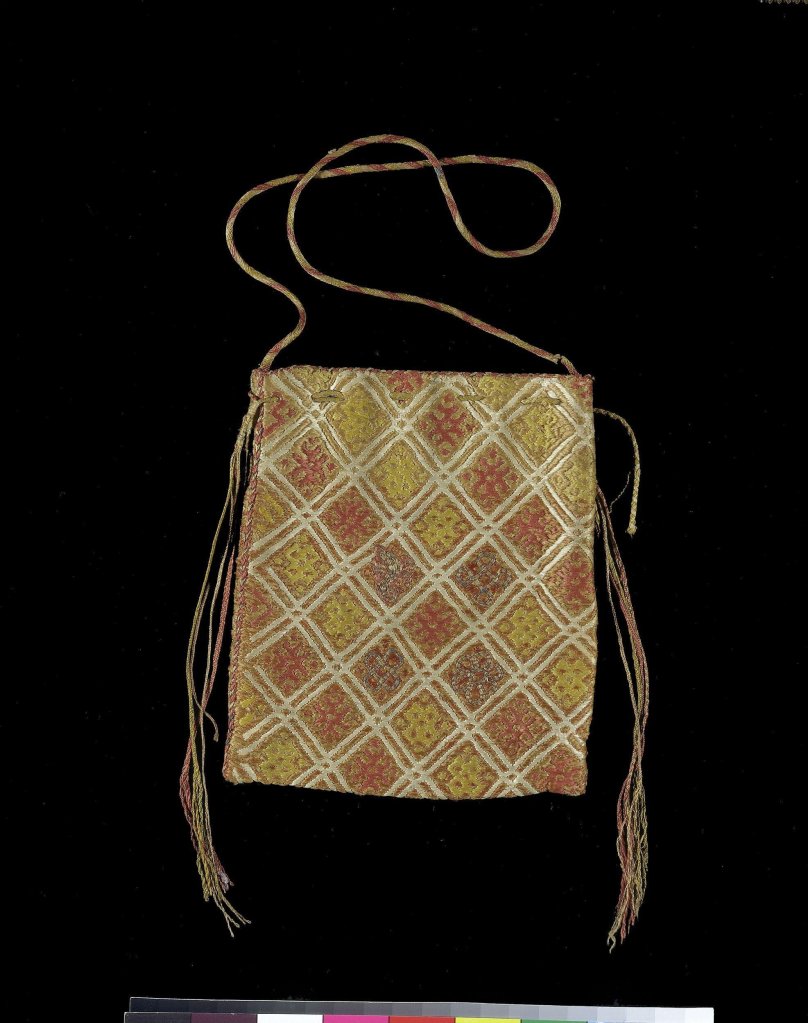
This bag is a reproduction of the 14th Century reliquary bag in the Victoria and Albert Museum (accession number 8313-1863). The small bag measures 5 ¾” by 5” and has an 18” long strap as well as tie closures. My research into brick stitch embroideries compiled a list of ten extant brick stitch bags (and various brick stitch fragments) in various museums and collections. Most of the museums and church treasuries identify these bags as reliquary bags, however that may not have been their initial purpose. These bags could have been used a variety of items including coins, candies/sweet meats, or alms. Many of these bags were used to hold relics and thus survive to modern day through the protection of church treasuries. During the early to mid-twentieth century many such bags were sold by treasuries to independent collectors who then donated them to museums.
Not much is known about the creators of brick stitch bags. Historians generally point to the areas of Lower Saxony and Westphalia as the origin of these bags, and indeed several brick stitch pieces survive in the collections of churches in the area. Because they use the same stitch patterns and methods of larger brick stitch embroidered altarpieces that have been connected to abbeys in this area, it has been suggested by scholars that they may have been made by nuns or workshops associated therein.
Brick stitch embroideries can be divided into two groups: figural illustrations and allover geometric patterns. The figural illustrative works are almost always liturgical vestments and alter cloths. Many such items survive, the most famous of which are the Hildesheim cope and the large 14th Century Wall Hanging now in the Cloisters at the Metropolitan Museum of Art. These pieces are either fully covered or include bare unstitched linen ground.
Items with all over geometric patterns are often found in the form of bags, pillows and stoles. These items have little to no figural aspect and are covered in complex geometric patterns. Some of these patterns can be identified as different abstract shapes such as birds, crosses, the letters “S” “X” “E” or “3” and often include octothorps (hashtags) and swastikas. These patterns have a direct link to patterns often found in extant tablet weaving finds. More detailed geometric patterns sometimes included heraldic devices depicting stylized people, birds and lions.
While a brick stitch bag is a sight ubiquitous to the SCA, these types of bags were made during a relatively short time period and limited geographical area. Scholars, often relying on the dating of cathedral treasuries, note that most of these items are from the 14th century. This style of embroidery was also restricted to a relatively small geographic area of the northwestern to central part of modern-day Germany and eastern Belgium.
Few illuminations of these bags exist, though that may be due to the difficulty of illustrating the complex patterns on a small scale. One such illumination from the Manesse Codex shows the vending of purses and belts to noble patrons, two of which appear to be decorated in complex geometric patterns of brick stitch. Indeed, the complexity and time that went into the production of these bags speaks to their material value.
Embroidery
My large brick stitch piece was not stitched on what we modernly refer to as “needlepoint canvas” but instead even weave fabric. Therefore, I wanted to expand my horizons and try out some canvas. The smallest size my local store sells is 18 counts per inch, so the motifs on my bag are roughly double that of the extant original (though all other measurements are the same).
I also used a modern stretcher bars and thumb tack method for stretching my work as I stitched rather than a Slate Frame. However, it works on the same principle, buy stretching the fabric evenly across a frame.
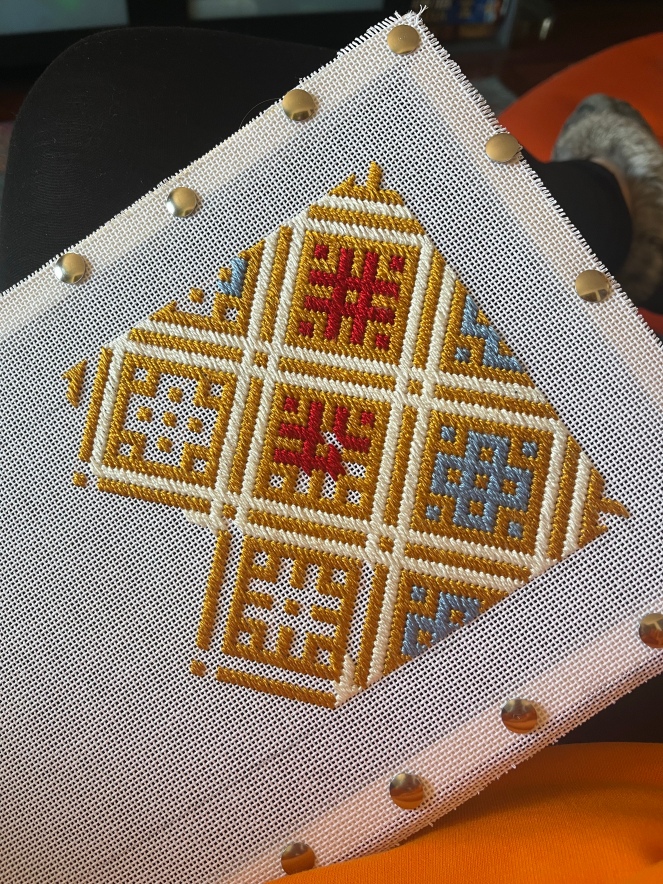
For this piece I again chose the 20/0 weaving silk from Eowyn De Weaver (as I have a lot left over). However, due to the large size of the canvas I had to use two strands of the gold and white and three strands of the blue and red to achieve adequate coverage.
The embroidery proceeded as expected without complication or issue. Stitching on the needle point canvas is even easier than stitching on even weave fabric and the project stitched up quicker than I expected it would.
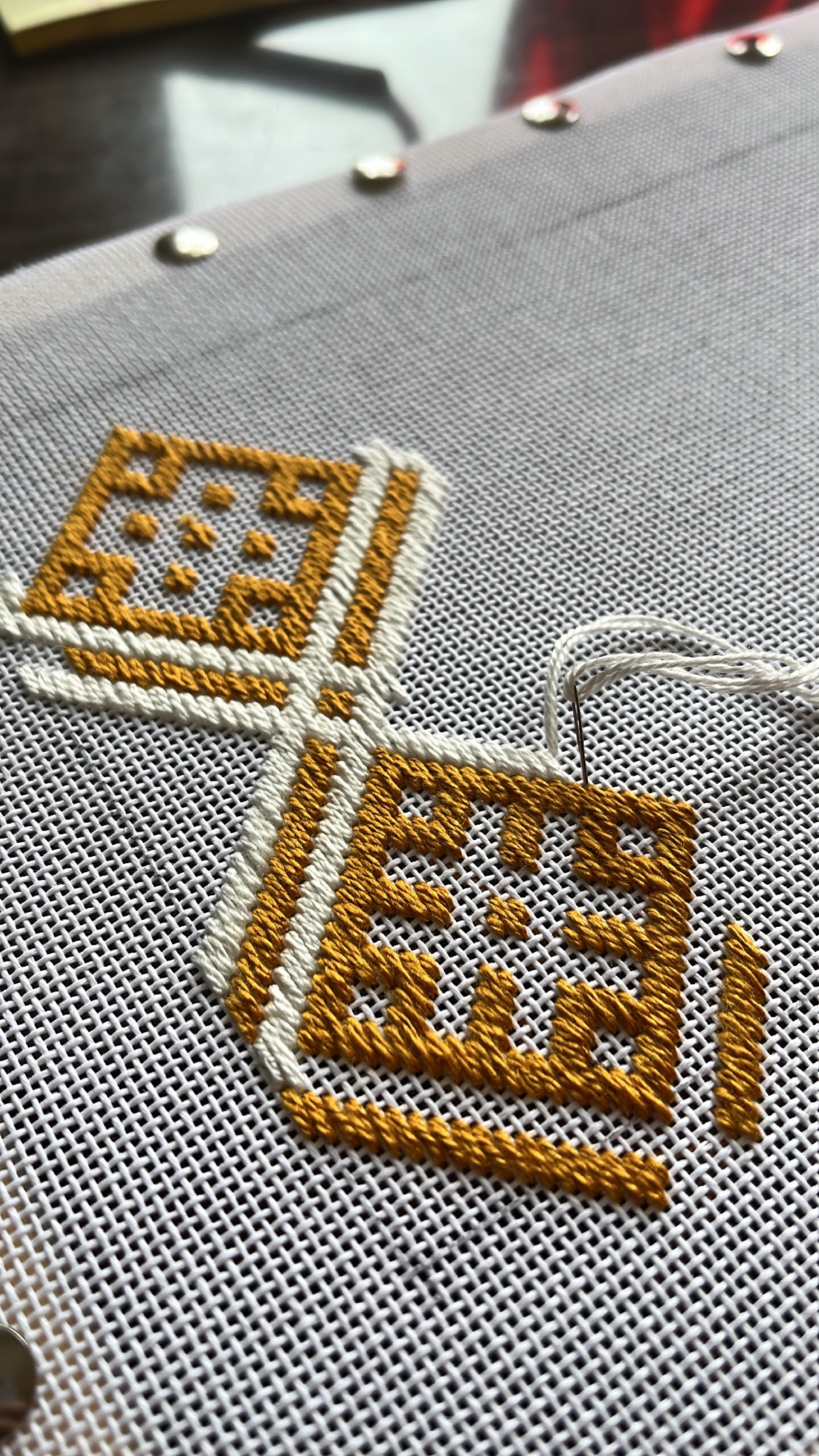
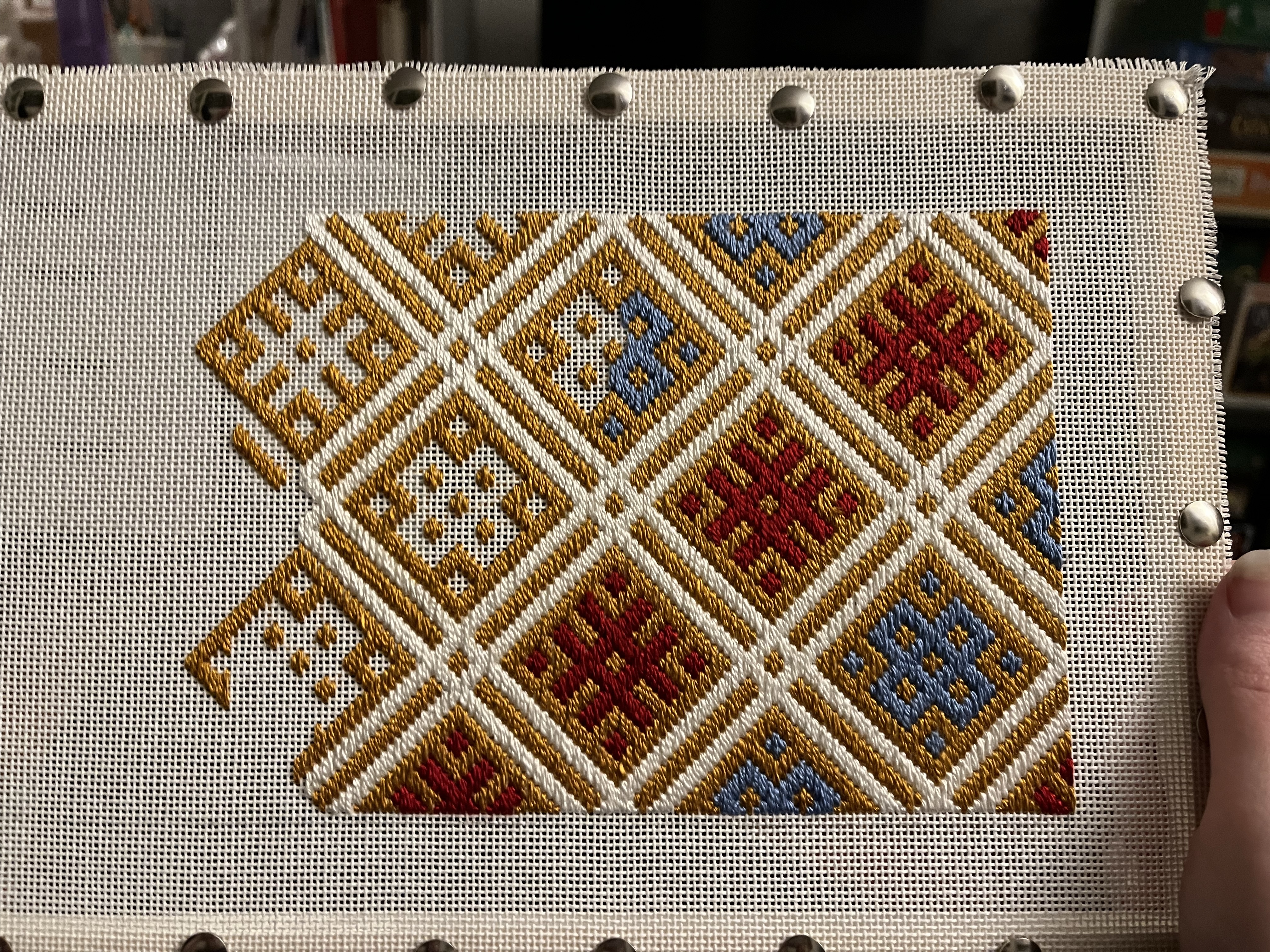
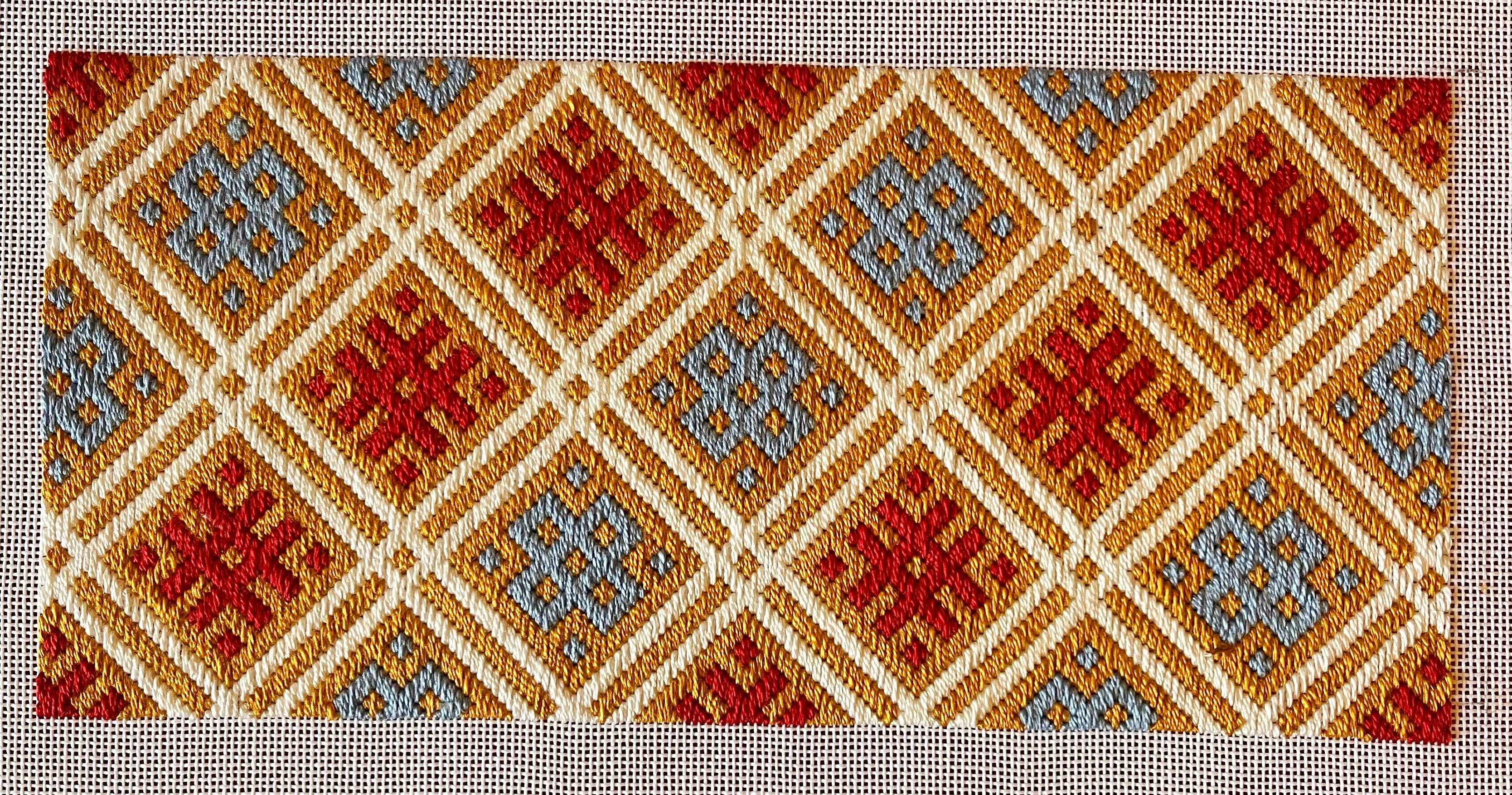
Construction
The first thing I did was remove the fabric from the frame, trim it, and slip stitch down the excess canvas.
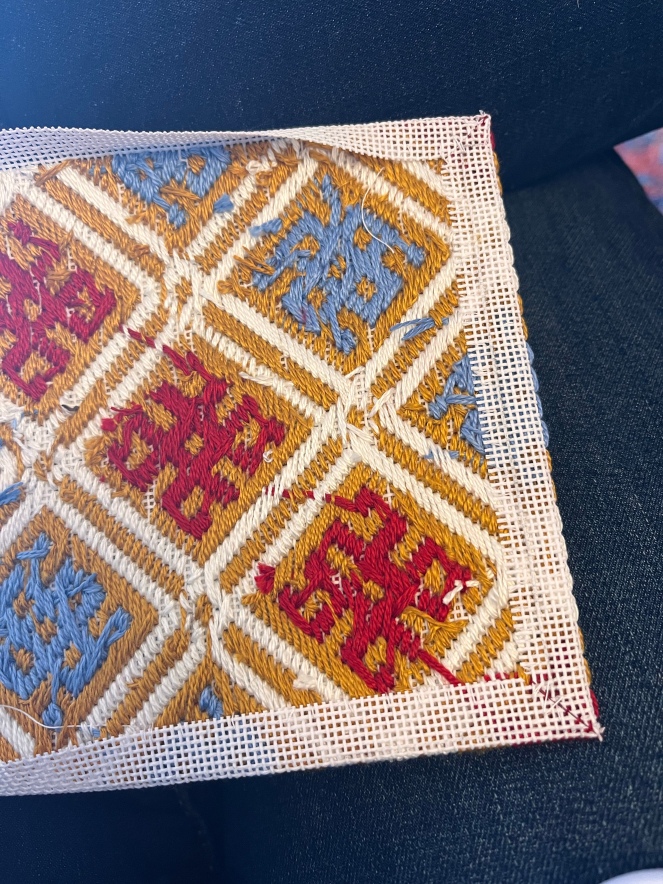
My research indicated that these bags were lined with all kinds of materials including leather, but many were lined with silk taffeta. The choice of lining of the bag likely pertained to the type of items that would have been inside, such as delicate relics or more hardly and dirty coins. I decided to line the bag with some gold silk plain weave sari fabric from my collection. I ironed and pressed it to be the same size as the brick stitch portion.
The original bag was stitched together with tablet woven seams. It is done using two tablets, one S threaded and one Z threaded, continuously turned either forward or backward, to produce this beautiful edging.
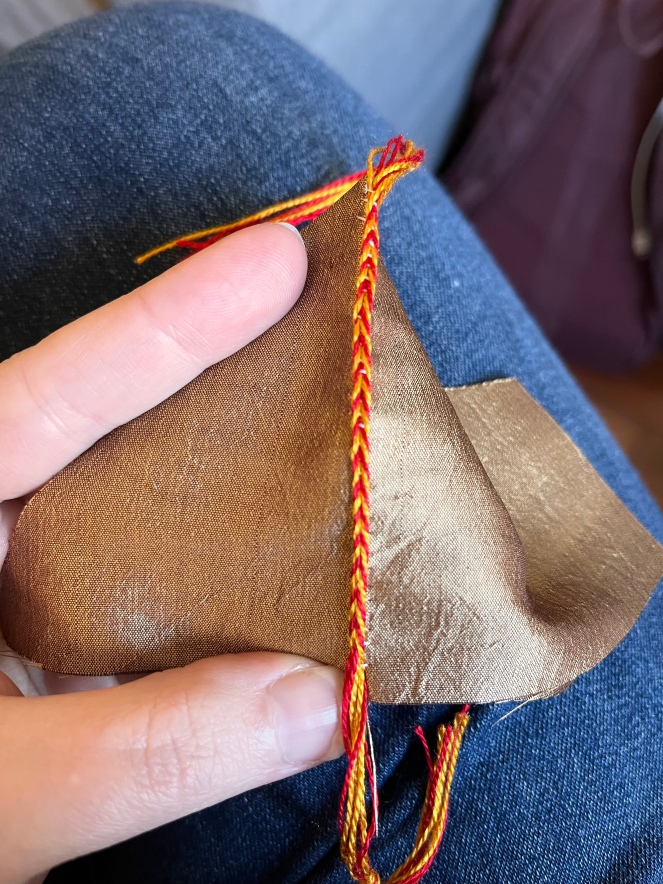
Rather than weaving a strip or band, you thread the weft on a needle (I used 60/0 silk for this purpose) and you go through the tablets right to left, and then take a stitch through your fabric left to right, which allows the warp threads to lay over the seam in this pleasing pattern.
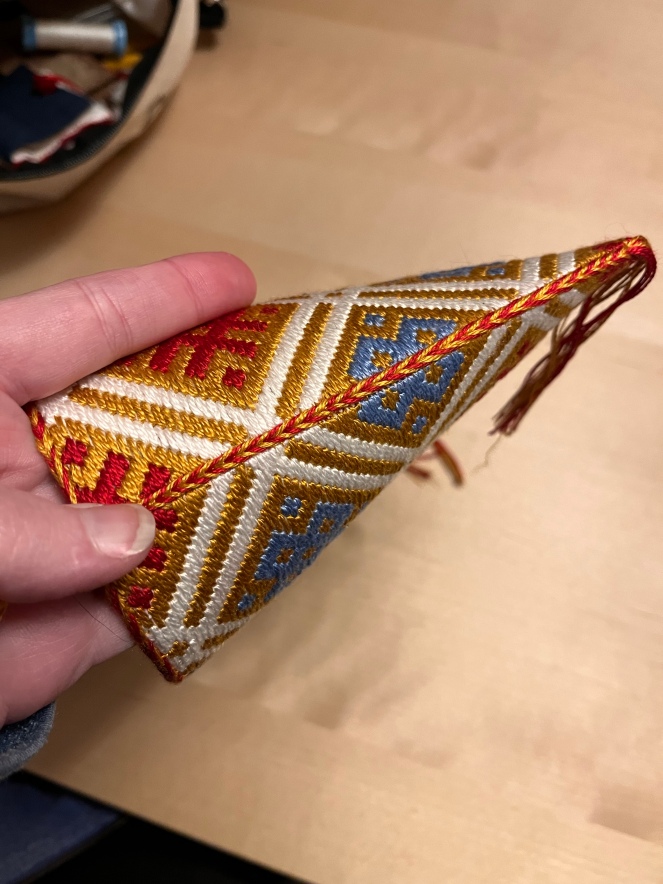
Tubular Tablet Woven Strap
The strap was the most unknown part of this project for me as, while I have done weaving before, this was my fist card weaving venture. For this, I borrowed an Inkle loom, and spent many hours warping and refining my tension. In medieval times this would have been done with a backstrap loom, or a stationary “Oseberg” type loom that involves tying the warps to two fixed bars to create tension while weaving.
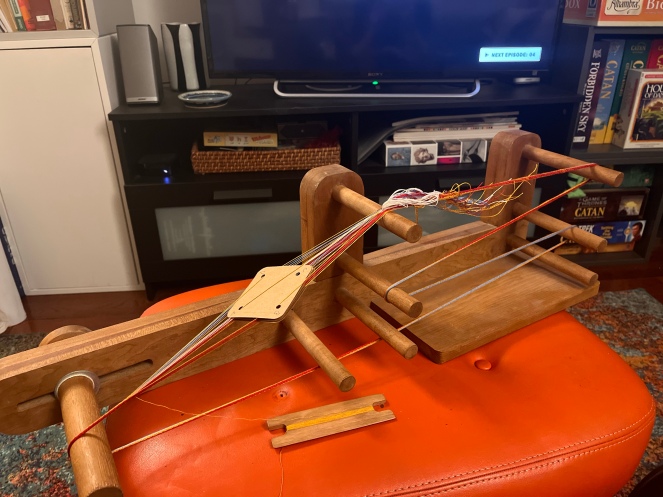
Tubular tablet weaving is a kind of narrow weaving which creates a tube and often appears on the edges of tablet woven bands. It gives the weaving strength, durability and hides the edges of the weft. In this case, its used to make a striped strap. Several other finds, including a string of rosary beads in the Museum of London use this method of construction.
This type of tubular weaving is quite different from other card weaving techniques. Five cards were threaded as such:

Note that the last card is threaded with only three threads. Skipping this thread helps give the weaving its tubular shape. Additionally, a core of 5 white silk threads were added to give the cord added bulk. These threads are largely ignored and pass through the center of the cards as the strap is woven. Cards are turned a quarter turn forward and back. The weft passes in a counterclockwise circle. First going left over all but the top “a” threads, and then going right under all but the bottom “c” threads. The cards are then turned a quarter turn forward, allowing the weft to pass over all but the top “b” thread and under all but the bottom “d” thread. The weft thread is pulled tightly to compress the threads into a tight cord.
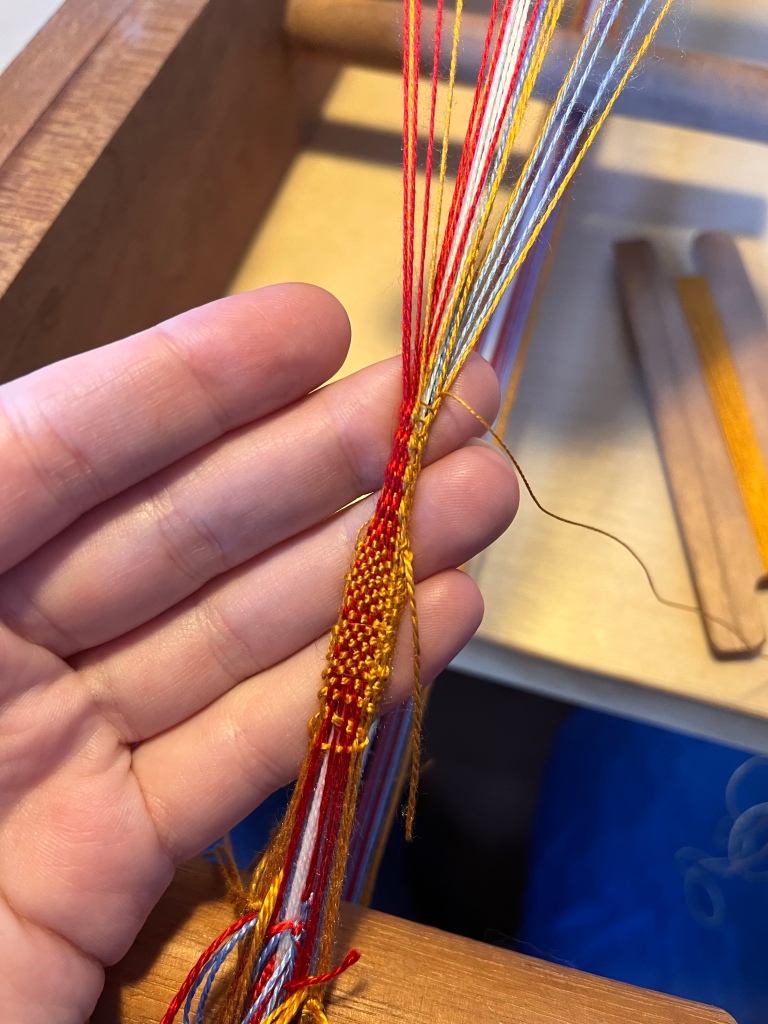
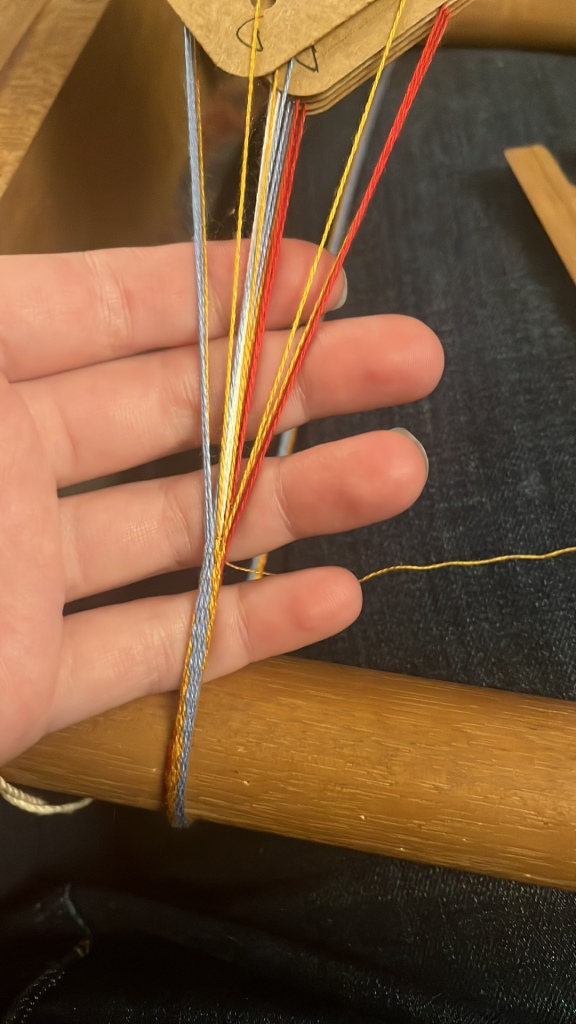
The above photos illustrate my initial use of a larger weft thread which did not produce a satisfactory weaving. After wracking my brain and trying different weft sizes I settled on a thin 1/60 size thread which was pulled tightly to produce the thin tubular strap. Due to the tight tension required I found it difficult to maintain a consistent width braid throughout the strap. This technique, learned through trial and error, produces a beautiful and strong strap and is a craft I intend to experiment more with in the future.
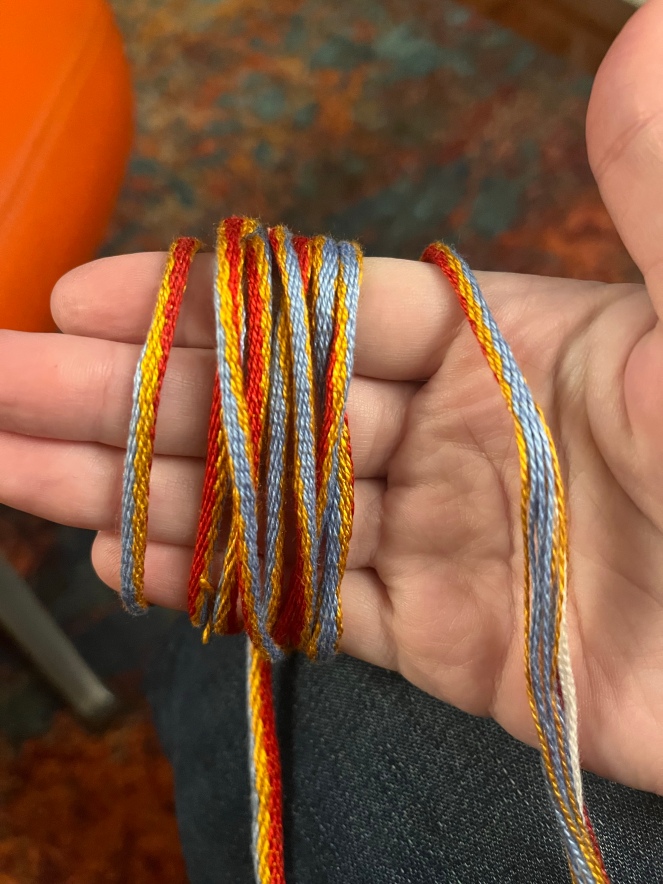
I cut off the ends of the tubular warp and tied overhand knots in them to insure they didn’t unravel. Then I sewed them using tiny hand stitches to the inside of the bag.
Fingerlooping
Fingerloop braiding was very popular in the high middle ages and we have a wealth of information on the practice available. The earliest known fingerloop braiding manual is Harley MS 2320 dating from the mid-15th century which includes the pattern for 40 fingerloop braids. However, we have archeological evidence for the fingerloop braids going back earlier. A small fourteenth century bag in the church treasury of Saint Vincent in Soignies appears to have a flat multistrand silk fingerloop braid for both the strap and sinching cord. Additionally, descriptions of fingerloop “laces” and braids appear throughout popular literature including Chaucer’s Canterbury Tails and Sir Gawaine the Green Knight as discussed by Treanor in her master’s Thesis.
Close examination of the photos of the bag from the V&A show tiny fingerlooped braids. It is difficult to determine if these braids are the ends of the cinching ties or the strap of the bag.
My initial guess was that they were the cinching tie closures of the bag. Thus, I braided two braids about 15 inches long. For the first five inches and the last five inches I used the pattern “Two Strings at once”. This creates two small braids that act as fringe. For the center of the braid, I used “a round lace of five bows”. Both patterns appear in the 1450 Harley Manuscript of fingerloop braiding.
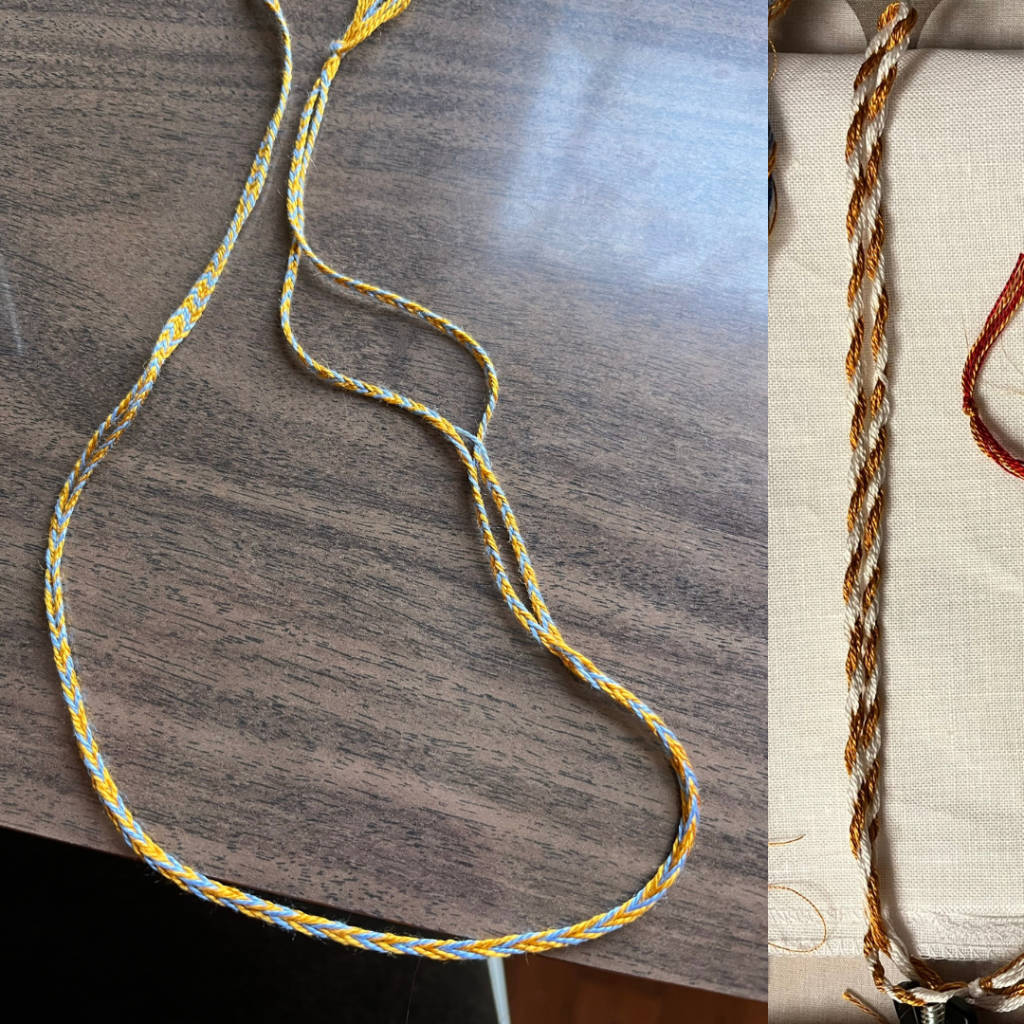
Under closer examination I believe the ties for this bag were likely braided with “A lace bend rounde of 8 bowes” from ca. 1475 braiding manual. It is possible that the ends of this braid or the tubular woven strap were then braided into “two strings at once” to create the effect of the tiny braids. However, I will not be able to determine this without seeing the bag in person.
Finished Bag
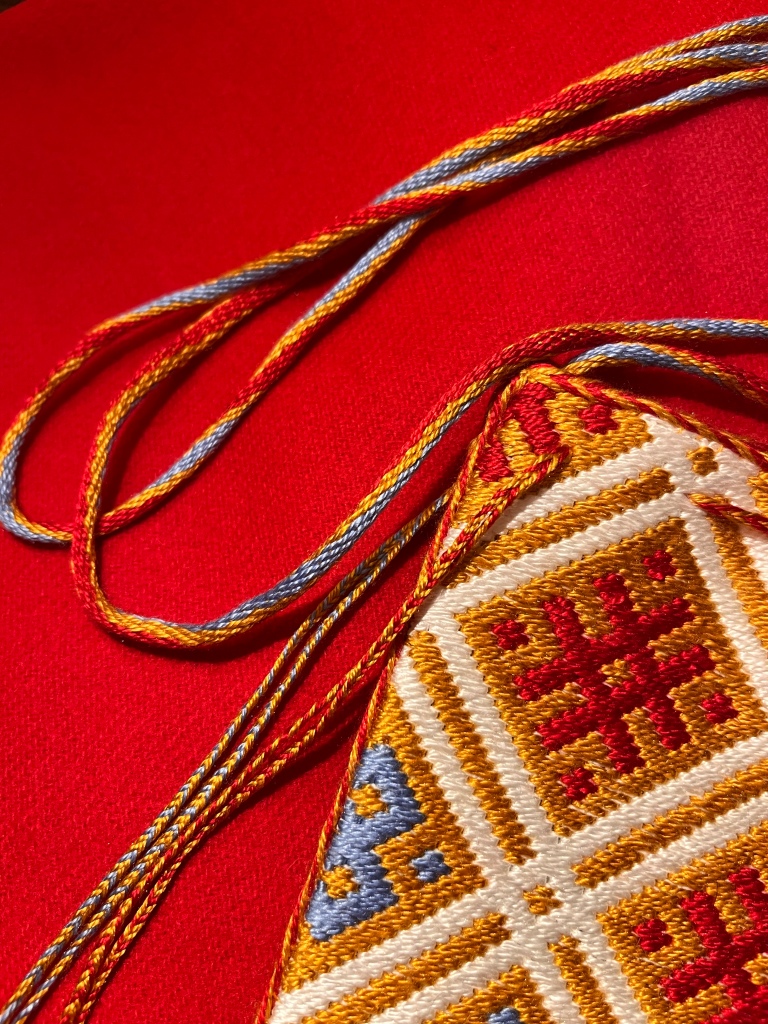
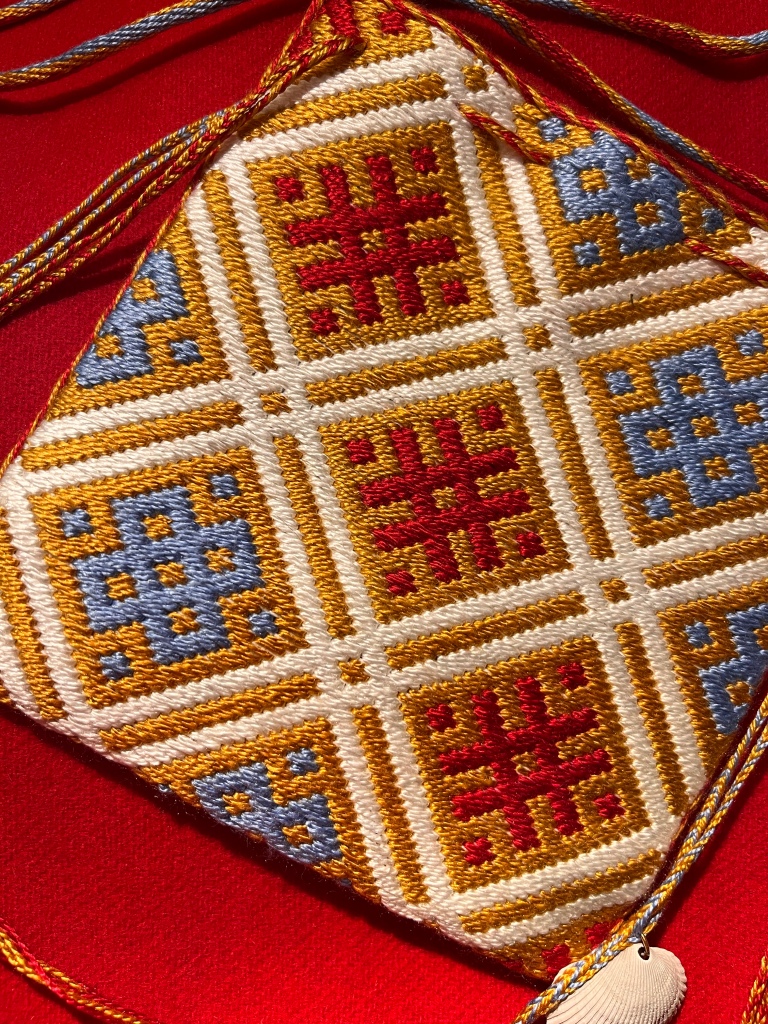
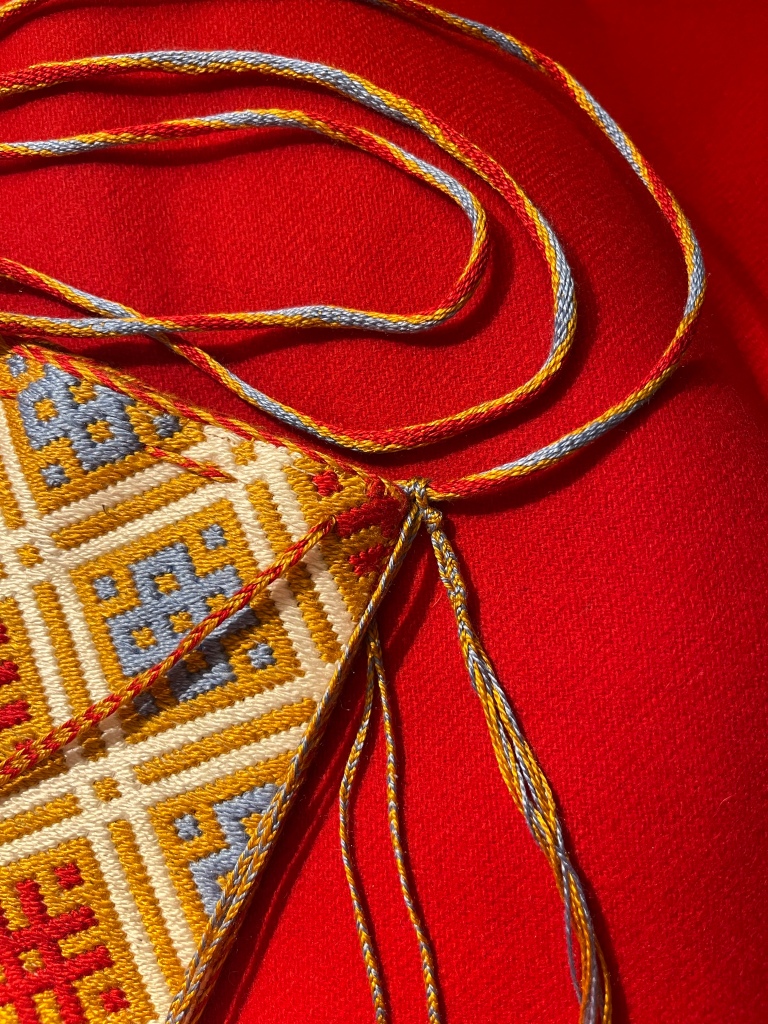
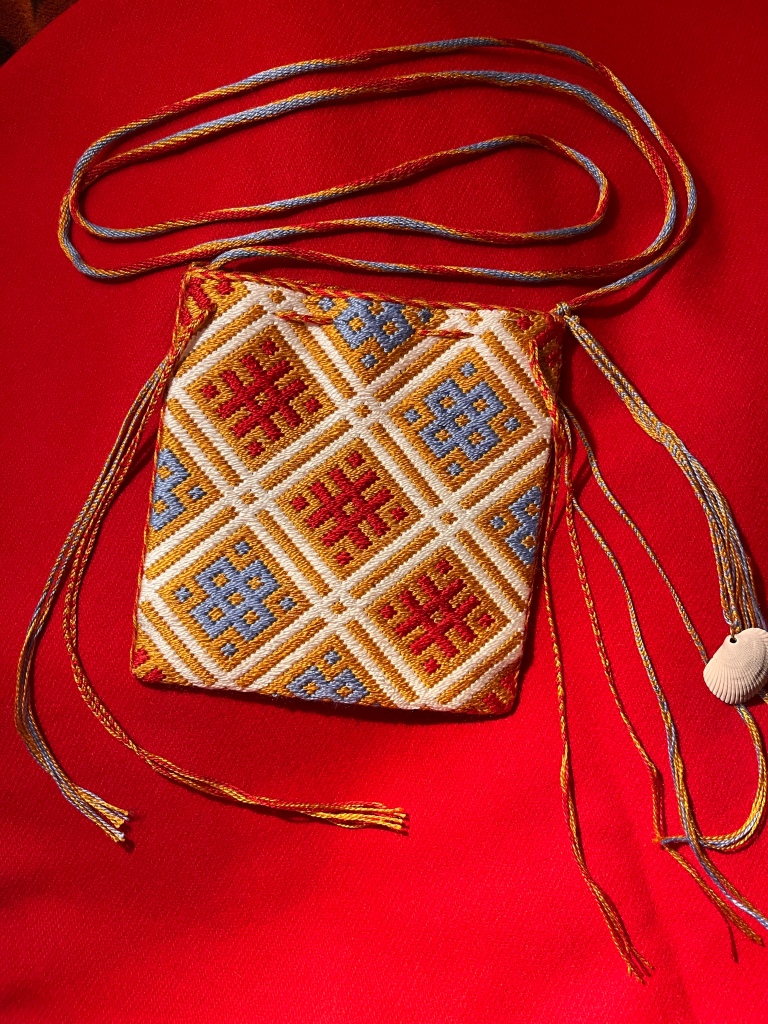
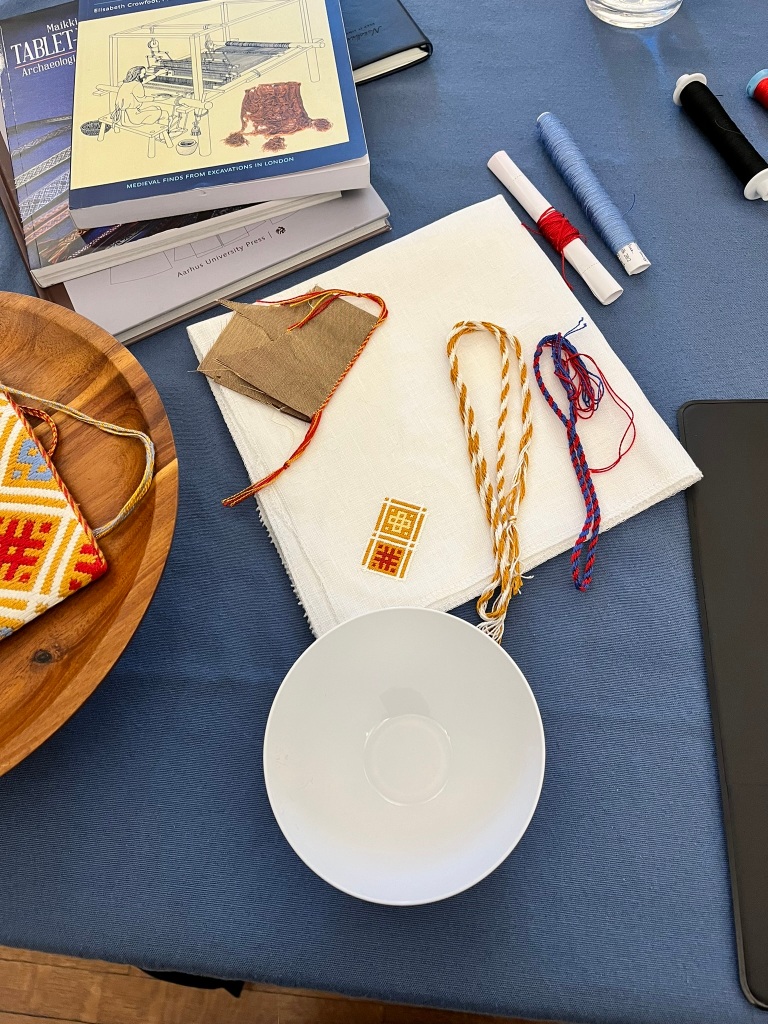
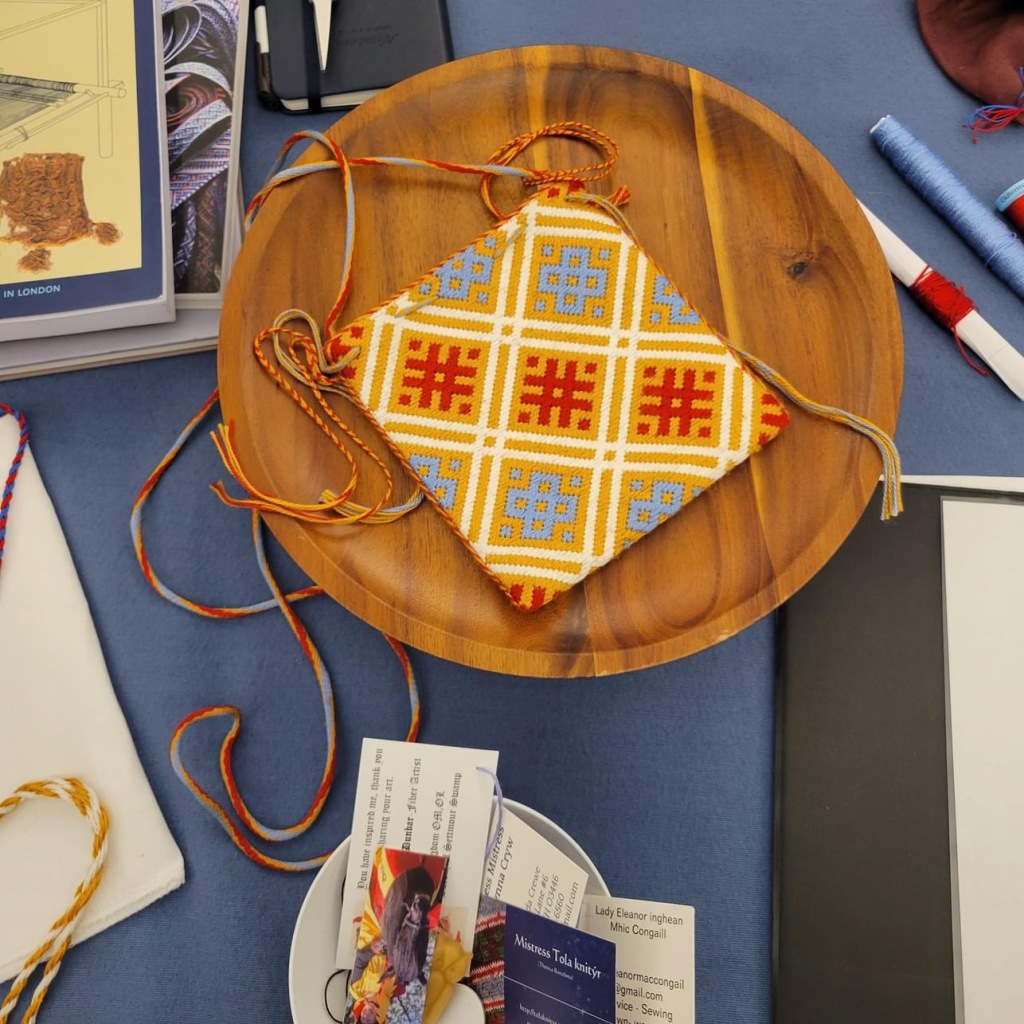
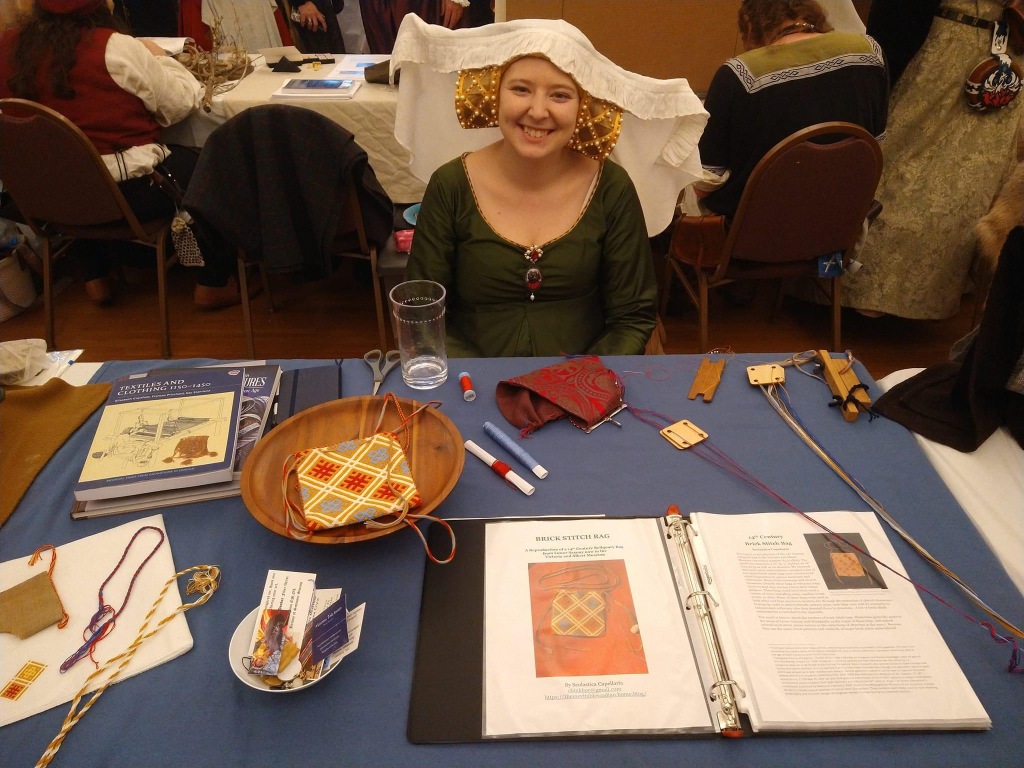
Final Thoughts:
The reproduction of this bag was an experience in learning disparate techniques of weaving and braiding and combining them with embroidery to re-create a period bag. Using period construction techniques including the tablet woven seams gives the bag a finished appearance that separates it from modern bags of similar styles. The production of the tubular weaving strap was the most difficult part of this project to master, however the bag would not be the same without it. The weaving is a difficult to learn, but important technique to add to my repertoire that I intend to use more in the future. Most importantly, this brick stitch bag is an important accessory for my fourteenth century personal, Scolastica Capellaria, a noble woman of Lower Saxony, whether she carries it to hold tokens, sweetmeats or alms, or commissions it to hold relics in her local church.
Bibliography:
General Sources:
Crowfoot, Pritchard and Staniland, Textiles and Clothing 1150-1450 (Museum of London, 1992).
Eco, Umbert, Art and Beauty in the Middle Ages (Yale University Press, republished 2002).
Tasha Dandelion Kelly, La Cotte Simple, “Aumonieres, Otherwise known as Alms Purses: Embellished textile purses in the French 14th Century” (Accessed 2/7/2024 https://cottesimple.com/articles/aumonieres/).
Flury-Lemberg, Mechthild, et al. Textile Conservation and Research: A Documentation of the Textile Department on the Occasion of the Twentieth Anniversary of the Abegg Foundation (Schriften der Abegg-Stiftung Bern, 1988).
Goubitz, Olaf, Purses in Pieces: Archaeological Finds of the Late Medieval and 16th Century Leather Purses, Pouches, Bags and Cases in the Netherlands (SPA Uitgevers 2009).
Linkspages at Larsdatter.com, “Pouches and Purses” (Accessed 2/7/24 http://www.larsdatter.com/pouches.htm).
Taschen, Blog on the Exploration and Reconstruction of Early-Through Late Medieval Purses, Pouches and Bags with a focus on Embroidery and other Methods of Surface Decoration. (Accessed 2/7/24, https://medievalpurses.blogspot.com/).
Power, Eileen. Medieval English Nunneries (1922).
Woodward Wendelken, Rebecca. “Wefts and Worms: The Spread of Sericulture and Silk Weaving in the West before 1300” Medieval Clothing and Textiles 10 (2014).
Brick Stitch Embroidery:
Mayer, Christa C. “An Early German Needlework Fragment.” The Art Institute of Chicago Museum Studies 6 (1971). pp. 68-69, ill. p. 68.
The Metropolitan Museum of Art. “Ninety-Ninth Annual Report of the Trustees of The Metropolitan Museum of Art for the Fiscal Year 1968-1969.” The Metropolitan Museum of Art Bulletin, n.s., 28, no. 2 (October 1969). p. 85.
Mitchel, Timothy (known as Richard Wymarc). A Stitch Out of Time: 14th and 15th Century German Counted Thread Embroidery (1995).
Mitchel, Timothy, “14 Pattern embroidered bag” Wymarc.com. Last Accessed 2/15/24: https://www.wymarc.com/index.php/9-a-stitch-out-of-time/14-pattern-y-011-an-embroidered-bag
Young, Bonnie. “Needlework by Nuns: A Medieval Religious Embroidery.” The Metropolitan Museum of Art Bulletin, n.s., 28, no. 6 (February 1970). pp. 263–277, fig. 1, 8–17.
Tubular Tablet Weaving and Tablet Woven Seams:
Collingwood, Peter. The Techniques of Tablet Weaving. (Echo Point Books, 1982).
Durham Weaver’s “Tablet Weaving: A filled Tubular Cord” video. https://www.youtube.com/watch?v=ctJHw7gZZKA, Accessed 2/15/24.
Durham Weaver. “Tablet Weaving: Weaving a Tubular Filled Cord” A Weaver’s Journal blog. https://durhamweaver64.blogspot.com/2023/02/tablet-weaving-weaving-tubular-filled.html, Accessed 2/16/2024.
Fransen Lilli, Anna Norgaard and Else Ostegard. Medieval Garments Reconstructed. (Aarhus University Press, 2011).
Karisto, Maikki & Mervi, Pasanen, Tablet-Woven Treasures (Mythologia Fennica, 2021).
Spies, Nancy. Ecclesiastical Pomp and Aristocratic Circumstance: A Thousand Years of Brocaded Tabletwoven Bands. (Arelate Studio, 2000).
Fingerloop Braiding:
British Library, Harley 2320, “Miscellany of treatises relating to prognostication, astrology and braiding in verse and prose.” Last accessed 2/15/2024: http://www.bl.uk/manuscripts/FullDisplay.aspx?ref=Harley_MS_2320
Swales, Lois and Zoe Kuhn Williams, “Fingerloop Braids”, Last Accessed 2/16/24: Fingerloop.org/patterns.html
Speiser, Noemi, Old English Pattern Books for Loop Braiding (2000).
Speiser, Noemi, Manual of Braiding, (1991).
Swales, Lois. Purse Strings and Lacing Points: Instructions from an early 15th Century Manuscript. (Self-Published, 1997).
Treanor, Pamela, “A Study of London, British Library Harley MS 2320: its Social Cultural and Economic environment” (Masters Thesis, University of Otago, May 2020).
List of Extant Brick Stitch Embroideries in Museums:
Note: This is not an exhaustive list. Many brick stitch items are held in European museum collections that are not digitized, private collections and church treasuries. This list represents those pieces which photographs are widely available.
Victoria and Albert Museum, London, England:
14th Century Bag, Germany. https://collections.vam.ac.uk/item/O115592/bag-unknown/ Linen ground with silk and white linen embroidery.
Hildesheim Cope, 1310-20, Germany Saxony. https://collections.vam.ac.uk/item/O113500/the-hildesheim-cope-cope-unknown/ Silk on linen. Wide tablet woven bands with brick stitch like designs.
Textile Fragment, 13th or 14th Century, Germany or Spain. https://collections.vam.ac.uk/item/O129988/textile-fragment-unknown/ Linen with silk embroidery.
Bag, Ca. 1400 to 1500, Germany. https://collections.vam.ac.uk/item/O144713/bag-unknown/ Linen ground with linen and silk embroidery.
Stole, 14th Century 1450-1550, Halberstadt Germany. https://collections.vam.ac.uk/item/O144715/stole-unknown/ Colored silk on linen, with later addition of goldwork. Three silk tassels.
Bag, 14th Century, German. https://collections.vam.ac.uk/item/O144712/bag-unknown/ Silk on linen
Textile, 16th Century. https://collections.vam.ac.uk/item/O361421/textile-unknown/ Linen and wool thread on canvas.
Embroidery, German 300-1499: http://collections.vam.ac.uk/item/O364078/embroidery/ Linen and silk thread on linen ground.
Embroidery, Habertstat Saxony, German, Linen 1300s, http://collections.vam.ac.uk/item/O364076/embroidery/ Linen and silk on linen.
Embroidery, 14th Century Germany, http://collections.vam.ac.uk/item/O364077/embroidery/ silk on linen
Panel, 14th Century, German: http://collections.vam.ac.uk/item/O364059/panel/?carousel-image=2021MW7819 Silk on linen (diamond brick stitch blocks).
Fragment, Germany or spain, 13th or 14th century: http://collections.vam.ac.uk/item/O364060/woven-silk-unknown/ silk on linen ground. Complex geometric shapes.
Cushion, 14th Century, German https://collections.vam.ac.uk/item/O318615/book-cushion/ Silk on linen, pairs of birds in octogons.
Maniple with lozenge pattern, 1300-99, german https://collections.vam.ac.uk/item/O362710/maniple/
Sundarium made of linen and embroider orphreys, 1400s german https://collections.vam.ac.uk/item/O319133/sudarium/
Metropolitan Museum of Art, New York, New York:
Embroideries with Allegorical Scenes, Ca. 1450 Lower Saxony, Germany: https://www.metmuseum.org/art/collection/search/477237 Silk and linen on woven linen ground with applied red pigment and black under/overdrawing.
Purse with Two Figures under a Tree, French, 14th Century: https://www.metmuseum.org/art/collection/search/466694 Silk on linen ground.
Embroidered Hanging, German 14th Century: https://www.metmuseum.org/art/collection/search/468750 SIlk on linen ground. From the Monastery of Wienhausen prior to 1940.
Museum Schnutgen:
Reliquary Bag, Rhineland, 14th to 15th century, https://www.museum-schnuetgen.de/Ways-to-discover-the-collection?kat=22 linen with silk embroidery and metal thread.
Collegiate Church of Soignies, Belgium:
Bag, 14th to 15th century, Europe, https://balat.kikirpa.be/photo.php?path=Z001903&objnr=10152670&nr=74 Silk on wool evenweave canvas. Includes Silk braded strap (fingerloop?) and fingerloop braided ties.
Reliquary Purse, 1288-1300, western Europe. https://balat.kikirpa.be/photo.php?path=Z001905&objnr=10152626&nr=6 Silk and silver thread on canvas, four strand braid strap. Leather lining
Church of Our Lady’s Nativity, Tongeren, Belgium:
Reliquary bag, 1291-1310, Western Europe, https://balat.kikirpa.be/object/40767 Silk and gold thread on linen.
Reliquary bag, 1291-1310, Western Europe https://balat.kikirpa.be/object/40752 Woolen fabric with embroidery in silk and gold thread
Relic bag, 1291-1300, Western Europe https://balat.kikirpa.be/object/43380 Silk embroidery on linen with multistrand green brad strap. Tablet woven seams also visible.
Kunstgewerbenmuseum, Berlin, Germany:
14th Century Embroidered Box, Westphalia Germany http://www.doctorbeer.com/joyce/emb/westbox/westbox.htm described by Joyce Miller.
Kloster Isenhagen, Hankensbüttel, Germany:
All photographed by The Saint Thomas Guild on their Blog Thomas Guild https://thomasguild.blogspot.com/2012/08/some-embroidered-cloth-from-kloster.html
Wool Embroidered cushion, 14th and 15th century, Wool on Linen Embroidery
Linen Alter cloth, 14th to 15th Century, 54 cm wide cloth of two fragments more than 2 meters long. Red linen with silk embroidery
Alter Cloth, 1350, 1.61 by 1 meter. Silk on linen. Brick stich figures with geometric border patterns